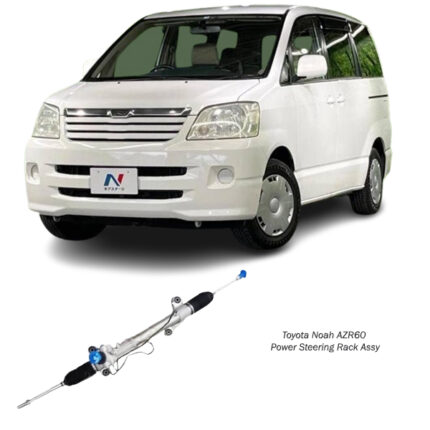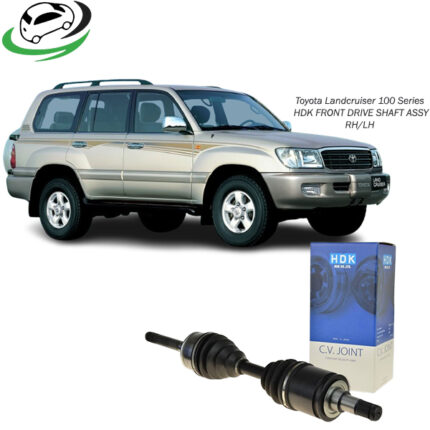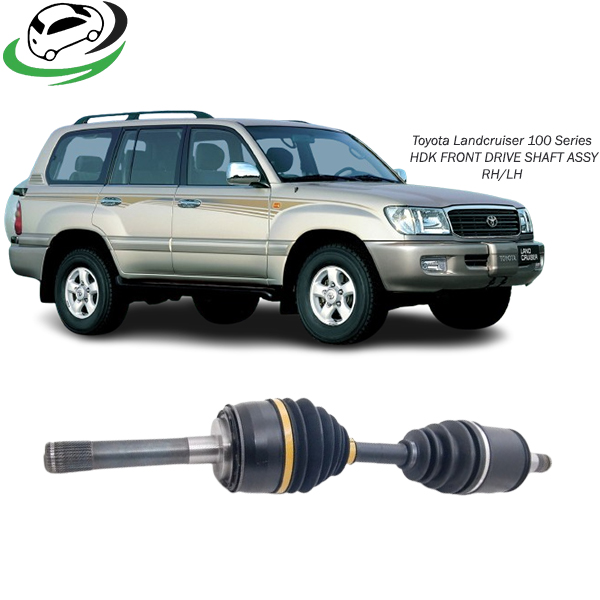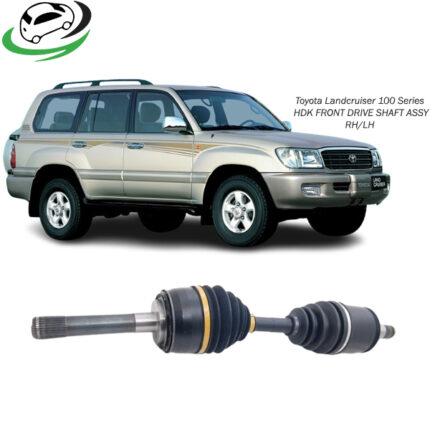-8%
Get Toyota Land Cruiser 100 Series Aftermarket Drive Shaft Assy 43430-60040
The Toyota Land Cruiser 100 Series is renowned for its robust design, reliability, and off-road capabilities. Like any 4WD vehicle, the drivetrain plays a crucial role in its performance, and a critical component of that drivetrain is the drive shaft assembly. The drive shaft is responsible for transmitting torque from the transmission to the front and rear differentials, which ultimately power the wheels. Over time, or through heavy use, drive shafts can wear out, and owners may need to consider replacing them. In such instances, aftermarket drive shaft assemblies present an excellent alternative to OEM (Original Equipment Manufacturer) parts, offering performance and cost advantages without compromising quality.
This detailed guide will explain the key aspects of an aftermarket drive shaft assembly for the Toyota Land Cruiser 100 Series, covering its components, functions, benefits, maintenance, and factors to consider when purchasing an aftermarket replacement.
Overview of the Drive Shaft Assembly
The drive shaft assembly in a 4WD vehicle like the Land Cruiser 100 Series is designed to manage the transmission of torque to the front and rear axles. In this model, there are two primary drive shafts:
- Front Drive Shaft: This transfers torque from the transfer case to the front differential, powering the front wheels.
- Rear Drive Shaft: This sends torque to the rear differential, driving the rear wheels.
Both shafts work in unison to ensure that power is evenly distributed to all four wheels, especially during off-road or low-traction conditions.
Key Components of the Aftermarket Drive Shaft Assembly
- Shaft Tube: The core of the drive shaft is the shaft tube, which can be made from steel or aluminum. Aftermarket drive shafts may offer different materials depending on the performance requirements. Steel is favored for its durability and ability to withstand high torque, whereas aluminum is lighter and can reduce rotational mass for slightly better performance and fuel efficiency. Both materials have their pros and cons, but aftermarket manufacturers usually design their drive shafts to handle the extreme conditions that a vehicle like the Land Cruiser 100 Series may encounter.
- Universal Joints (U-joints): Universal joints are located at both ends of the drive shaft and allow it to rotate while also compensating for the various angles created by the suspension’s movement. Aftermarket U-joints are typically made from high-strength steel to resist wear and tear, especially in off-road driving. The quality of these joints is critical in determining the longevity and performance of the drive shaft.
- Slip Yoke: The slip yoke allows for length variation as the suspension moves up and down, compensating for changes in distance between the transfer case and the differential. This feature is particularly important in off-road situations where the vehicle is often moving over uneven terrain. Aftermarket slip yokes are often built to tighter tolerances, reducing wear and improving the overall strength of the assembly.
- Center Bearing (if applicable): In vehicles like the Land Cruiser 100 Series, a center bearing may be used to support the drive shaft in longer-wheelbase configurations. The center bearing stabilizes the drive shaft and minimizes vibrations. Aftermarket assemblies often include high-quality center bearings to ensure smooth power transfer and durability under harsh conditions.
- Flange Yokes: These connect the drive shaft to the transmission or transfer case and the differential. Aftermarket flange yokes are generally designed to handle high torque loads, ensuring a secure connection to the drivetrain components without excessive wear or failure under stress.
Functions of the Aftermarket Drive Shaft Assembly
- Torque Transmission: The primary function of the drive shaft assembly is to transmit torque from the engine, through the transmission, to the axles. In a 4WD system, both the front and rear axles need to receive power, so the drive shaft assembly ensures that torque is split appropriately between the two. The aftermarket drive shaft must ensure efficient and smooth power transmission without excessive noise, vibration, or harshness.
- Handling Suspension Movement: The suspension system in the Land Cruiser 100 Series allows for significant movement, especially in off-road conditions. The drive shaft assembly needs to compensate for these movements without breaking or losing efficiency. Aftermarket drive shafts are designed to handle a wide range of angles and loads, ensuring continuous operation even when the suspension is fully compressed or extended.
- Vibration Damping: A well-designed aftermarket drive shaft assembly helps reduce vibrations caused by rotational imbalances, improving ride quality and reducing wear on other drivetrain components like the transfer case, differential, and transmission. Aftermarket manufacturers often balance their drive shafts to precise standards, minimizing the risk of excessive vibrations.
- Supporting Off-Road Performance: For the Land Cruiser 100 Series, off-road capability is a major consideration. The drive shaft assembly must be strong enough to handle extreme conditions such as steep inclines, uneven terrain, and water crossings. Aftermarket drive shafts are typically reinforced to handle these conditions, offering greater resistance to torsional stress, bending, and impact damage.
Benefits of Aftermarket Drive Shaft Assemblies
- Cost-Effective: One of the main advantages of aftermarket drive shafts is the cost savings compared to OEM parts. Aftermarket manufacturers often produce drive shafts in large volumes, allowing for reduced prices while still maintaining high quality. For Land Cruiser 100 Series owners, this can be a significant benefit, as OEM parts for these vehicles can be quite expensive.
- Performance Upgrades: Many aftermarket drive shafts offer improved performance over the factory-installed parts. These upgrades can include better materials, tighter tolerances, and stronger U-joints or slip yokes. For owners who push their vehicles to the limit, whether in off-road adventures or heavy towing, aftermarket drive shafts can offer enhanced durability and performance.
- Availability of Custom Options: Aftermarket suppliers often offer customizable options for drive shafts. Whether it’s a specific length, material type, or heavy-duty components, aftermarket drive shafts can be tailored to meet the specific needs of the user. This is particularly useful for those who have modified their Land Cruiser 100 Series with suspension lifts, larger tires, or other drivetrain modifications.
- Durability in Harsh Conditions: Many aftermarket drive shafts are designed with harsh conditions in mind, offering increased resistance to corrosion, wear, and damage. For Land Cruiser owners who regularly take their vehicles off-road or in extreme climates, aftermarket drive shafts can provide the peace of mind that the component will last longer under tough conditions.
Maintenance and Longevity Tips
To ensure that an aftermarket drive shaft assembly lasts for as long as possible, proper maintenance is essential. Here are a few tips:
- Regular Inspection: Periodically check the drive shaft for any signs of wear, such as cracks in the shaft tube, excessive play in the U-joints, or damage to the slip yoke. Identifying issues early can prevent further damage and costly repairs.
- U-Joint Lubrication: Many aftermarket drive shafts come with greaseable U-joints, allowing the owner to lubricate them periodically. Keeping the U-joints well-lubricated reduces friction and wear, extending their lifespan.
- Balancing: If you notice any vibrations during driving, it may indicate that the drive shaft needs to be rebalanced. Aftermarket drive shafts are typically well-balanced from the manufacturer, but changes in the drivetrain (such as adding a lift kit) can alter the balance. Regular balancing checks will help maintain smooth performance.
- Off-Road Care: After heavy off-road use, check the drive shaft for any signs of damage, such as dents or bends. Rocks, mud, and other debris can cause impact damage, especially in rough terrain.
Considerations When Purchasing Aftermarket Drive Shafts
- Compatibility: Always ensure that the aftermarket drive shaft is designed specifically for the Toyota Land Cruiser 100 Series. Compatibility is crucial for proper fitment and performance, as different models and years may have slightly different drivetrain setups.
- Material Quality: Check the materials used in the construction of the drive shaft. High-strength steel or aluminum are preferred for durability and performance, especially in off-road conditions. Some aftermarket brands may offer varying grades of materials, so it’s important to choose one that suits your driving needs.
- Brand Reputation: Not all aftermarket manufacturers are created equal. Research the brand and read reviews from other Land Cruiser owners to ensure that the drive shaft you’re purchasing has a good track record for durability, fitment, and performance.
- Warranty: A good aftermarket drive shaft should come with a warranty that covers defects in materials or workmanship. This provides additional peace of mind in case there are issues with the drive shaft after installation.
Conclusion
The aftermarket drive shaft assembly for the Toyota Land Cruiser 100 Series is a crucial component for maintaining or enhancing the vehicle’s drivetrain performance. With the right aftermarket drive shaft, owners can enjoy cost savings, performance improvements, and durability in harsh driving conditions. Whether you’re using your Land Cruiser for daily driving, heavy towing, or off-road adventures, a high-quality aftermarket drive shaft assembly will ensure that power is efficiently transmitted to the wheels, keeping your vehicle running smoothly and reliably for years to come.
Follow us on Facebook for more parts.




